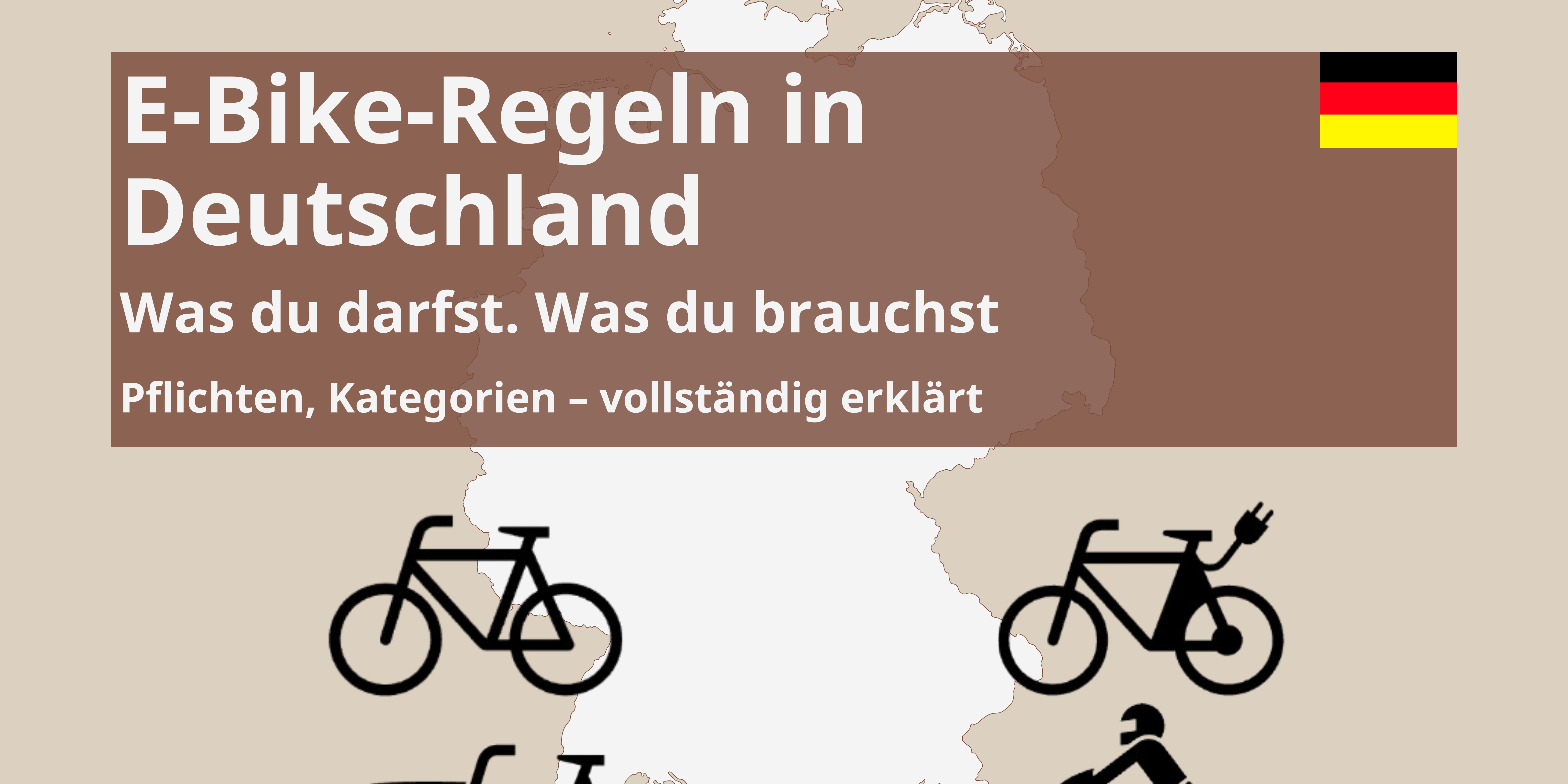E-bike regulations & rules in Germany
- Home
- E-bike knowledge
- E-bike regulations & rules in…
Whether with a child seat, shopping bag or tools – e-bikes and cargo e-bikes have long since become part of everyday life, but do you know what rules you need to follow to stay on the safe side?
In this article, we explain which regulations apply to the different types of e-bike and what riders need to look out for in order to ride safely and in compliance with the law.
Different types of e-bikes and electric vehicles
The terms e-bike and pedelec are often used interchangeably, although there are technical and legal differences. In principle, the following applies:
A pedelec is an electric bicycle with pedal assistance up to 25 km/h, which is legally treated like a normal bicycle – no driving license, no compulsory insurance and the use of cycle paths is permitted. In everyday language, pedelecs are often simply referred to as “e-bikes”.
If you want to go faster, you can opt for an S-pedelec. These models support pedaling up to 45 km/h, but require an insurance plate, a driver’s license (class AM) and are not allowed to ride on cycle paths. Legally, they are classed as mopeds. In practice, S-pedelecs are often referred to as “fast e-bikes”.
E-bike (in the narrower sense) – without pedal assistance
In addition to pedelecs, there are also e-bikes without pedal assistance, which are propelled solely by the motor. Models with a speed of up to 25 km/h are legally classified as mopeds and require a moped test certificate, a helmet and an insurance license plate. Even more powerful e-bikes without pedal assistance up to 45 km/h fall into the moped category, require a category AM driving license and are only permitted on the road.
Important to know! In this article, we look at the pedelec and S-pedelec categories.
At a glance: The differences between pedelec and S-pedelec
Pedelecs (e-bikes & cargo e-bikes up to 25 km/h)
- Motor power: max. 250 W
- Maximum speed: 25 km/h (pedal assistance)
- No age limit
- No driver’s license required
- Helmet recommended, but not compulsory
- Starting and pushing assistance up to 6 km/h permitted
- May use cycle paths (marked cycle paths must be used)
- Blood alcohol limit: 1.6 per mille
- No insurance or licensing requirement
- Is considered a bicycle and is subject to the relevant traffic regulations
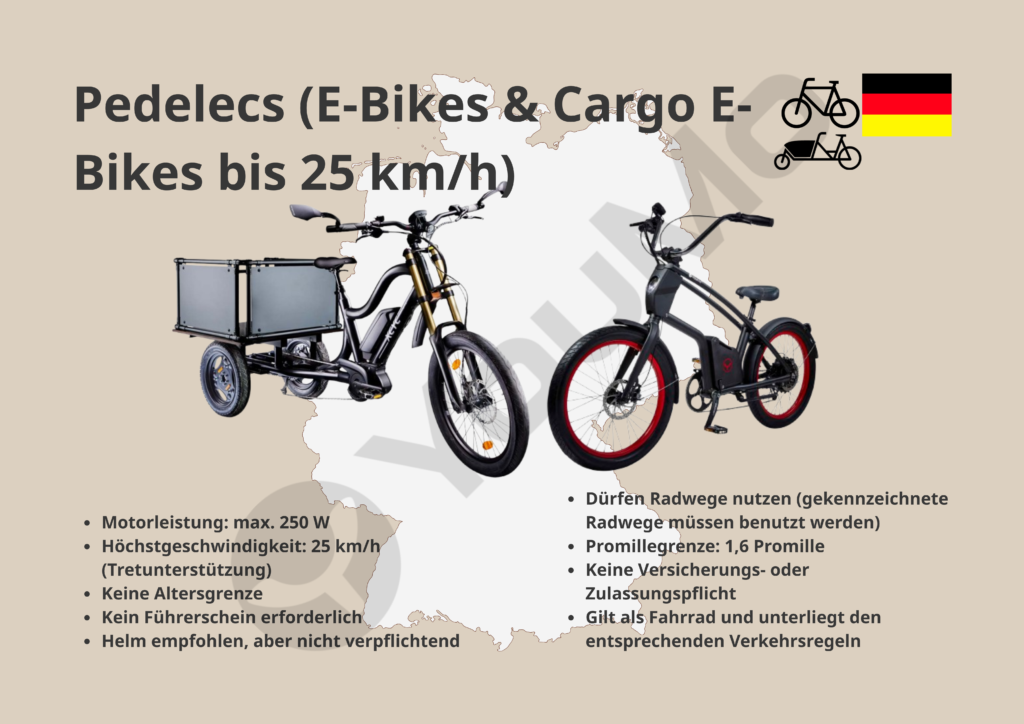
S-pedelecs (fast e-bikes & fast cargo e-bikes up to 45 km/h)
- Motor power: max. 4,000 W
- Maximum speed: 45 km/h (pedal assistance)
- Minimum age: 16 years
- Disc assist: up to 6 km/h
- Driving license required (class AM, included in car driving license)
- Helmet compulsory (suitable motorcycle helmet required)
- May not use cycle paths, only allowed on the roadway
- Is considered a moped, requires a road license
- Insurance license plate required
- Rear-view mirror, side reflectors, horn and brake light mandatory
- Blood alcohol limit: 0.5 per mille (as for cars)
- No trailer allowed
- Liability insurance required
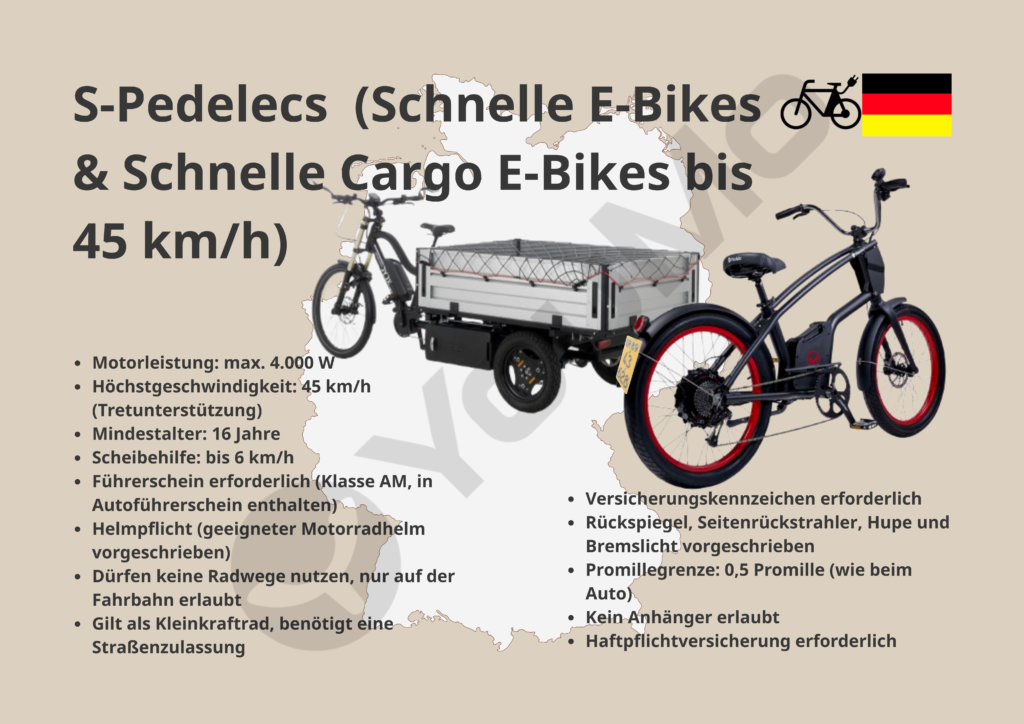
Cargo e-bikes - regulations for cargo bikes
As long as the motor power is a maximum of 250 watts and the pedal assistance ends at 25 km/h, e-cargo bikes are considered bicycles according to the StVO.
This means: no driving license requirement, no registration – and cycle paths can be used as usual. The only important thing is that suitable seats are used when transporting children so that everyone is safe on the road.
Dimensions & technical classification
Certain requirements must be met for a cargo e-bike to be legally considered a bicycle:
- Maximum speed (pedal assistance): up to 25 km/h
- Motor power: maximum 250 watts
- Starting aid: permitted up to 6 km/h
- Width:
- Single-track: up to 1 meter
- Multi-track (e.g. tricycle): up to 2 meters
- Length: up to 4 meters
If one of these limits is exceeded or the e-bike reaches more than 25 km/h with motor assistance, it is no longer a bicycle but a motor vehicle. In this case, different rules apply: Compulsory insurance, registration and a class AM driver’s license are required.
Equipment according to StVO
According to the German Road Traffic Regulations (StVO), a cargo e-bike must have the same equipment as a normal bicycle:
- Two independent brakes
- Lighting in accordance with regulations (white at the front, red at the rear)
- Reflectors (pedals, spokes, front/rear)
- Bell as an acoustic warning signal
- Rear-view mirrors are not mandatory, but make sense for larger models
There is no obligation to wear a helmet, neither for the driver nor for passengers. Nevertheless, wearing a helmet is strongly recommended – especially when carrying a heavy load or transporting children.
Taking children with you on the Cargo E-Bike
Children may be carried on cargo bikes provided the vehicle is structurally suitable and equipped for this purpose. For pedelecs up to 25 km/h, several children may also be taken along – for example in a closed transport box with a belt system.
Unlike the classic bike with a child seat, there is no age limit for the child riding along, as long as safety is guaranteed. However, the rider must be at least 16 years old.
Please note: The transportation of children is not permitted on S-pedelecs (up to 45 km/h). These vehicles are classed as mopeds and passengers are not permitted on them.
Parking in public spaces
Cargo bikes may be parked in the same way as bicycles – for example on the sidewalk, on bicycle stands or in specially designated parking areas. Care must be taken to ensure that no access roads, footpaths or escape routes are blocked.
Since the amendment to the road traffic regulations, there are also special traffic signs for cargo bike parking spaces. These can often be found in urban zones, in front of schools, supermarkets or at train stations. Parking on the side of the road is also permitted if local conditions allow.
Speed and road use
Maximum speed for e-bikes & cargo e-bikes
How fast you can ride an e-bike depends on the category.
Pedelecs and support pedaling up to a maximum of 25 km/h. Once you reach this speed, the motor switches off automatically. As they are legally considered bicycles, you do not need a registration or a driver’s license.
The situation is different for S-pedelecs. They support pedaling up to 45 km/h and therefore count as mopeds. This means that a class AM or B driving license, registration and an insurance plate are mandatory.
Riding areas for e-bikes & cargo e-bikes - What is permitted?
Bicycles and pedelecs only have to ride on the cycle path if it is usable and a blue cycle path sign obliges them to do so. If there is no cycle path, you may ride on the road.
S-pedelecs, on the other hand, are not allowed to use cycle paths. They are only permitted on the road and must comply with the applicable traffic regulations for motorized vehicles. They may only be ridden on cycle paths if the additional sign “E-bikes free” or “E-bikes and mopeds free” permits this.
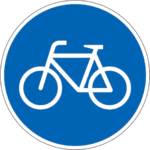
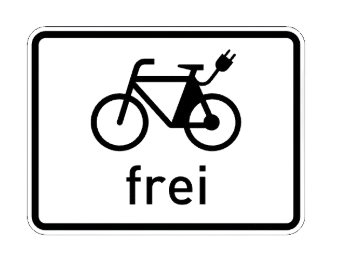
Signaling for e-bikes & cargo e-bikes - What applies where?
To ensure that e-bikes and cargo e-bikes are safe and comply with the rules, it is important to have the right signaling. It is important to know which traffic areas are permitted for pedelecs, S-pedelecs and cargo e-bikes – because there are clear differences here.
Technical regulations and approval requirements
Registration & insurance obligations for e-bikes & cargo e-bikes
The registration and insurance obligations for e-bikes also depend on the respective vehicle category. Pedelecs and cargo e-bikes with a motor assistance of up to 25 km/h and a maximum power of 250 watts are legally considered bicycles. Therefore, neither a registration nor an insurance license plate is required. Liability insurance is not mandatory, but is advisable in order to be covered in the event of damage.
The situation is different for S-pedelecs. These fast e-bikes, which support pedaling up to 45 km/h, are considered mopeds. An insurance license plate is mandatory here, which must be clearly visible at the rear. You also need liability insurance – without this, the S-pedelec may not be used in road traffic.
What safety requirements must e-bikes meet?
Whether pedelec, cargo e-bike or S-pedelec – all e-bikes must meet certain safety standards. These include two independently functioning brakes that ensure reliable deceleration. The lighting must also comply with the Road Traffic Licensing Regulations (StVZO). This means: a white front headlight, a red rear light and reflectors on the pedals and wheels.
At least one bell is mandatory for all e-bike types so that you can warn other road users. S-pedelecs even require a horn and a rear-view mirror.
If you adhere to these requirements, you will not only drive safely, but also avoid fines and trouble during traffic checks.
Parking & parking facilities
Where can I park my e-bike or cargo e-bike?
E-bikes may be parked in public spaces in the same way as bicycles. This means: at bike racks, on designated parking spaces or in suitable places on the roadside. The only important thing is that no sidewalks or driveways are blocked.
Many cities now offer special parking facilities, which often also have charging options. Such charging stations can often be found at train stations, central squares or shopping centers. This allows you to charge your e-bike while you are parked – handy if you are out and about for a while.
Helmet requirement & safety regulations
Is a helmet mandatory for e-bikes?
The helmet requirement for e-bikes also depends on the respective category. Helmets are not compulsory in Germany for pedelecs and cargo e-bikes that provide assistance up to 25 km/h. Nevertheless, wearing a helmet is strongly recommended – especially at higher speeds, a helmet can prevent serious injuries.
Helmet compulsory for fast e-bikes & S-pedelecs
For S-pedelecs, which can travel at speeds of up to 45 km/h, the situation is different. Here, the German Road Traffic Act (StVO) stipulates that a helmet must be worn in accordance with ECE standard R22-05. This standard also applies to motorcycle helmets and ensures that the helmet meets high safety requirements.
Lighting and safety equipment
Lights compulsory for e-bikes
E-bikes are subject to clear lighting requirements in accordance with the German Road Traffic Licensing Regulations (StVZO). Pedelecs and cargo e-bikes must be equipped with a white front headlight and a red rear light. This lighting may be operated either via the e-bike battery or separate batteries. Functioning lights are essential, especially when riding at dusk or in bad weather.
S-pedelecs are subject to stricter regulations. They also require a daytime running light, which must be switched on during the entire ride.
Reflectors, rear-view mirrors & other regulations
In addition to active lighting, reflectors are mandatory: yellow pedal reflectors, white at the front, red at the rear and side reflector strips or spoke reflectors.
A rear-view mirror is only mandatory for S-pedelecs. This must be fitted on the left-hand side in order to keep an eye on traffic. A mirror is not mandatory for pedelecs and cargo e-bikes, but can be useful and increase safety on the road.
Additional safety measures
The regulations mentioned are important, but they are not the only protective measures. Gloves not only protect your hands in the event of a fall, but also provide a better grip on the handlebars. If you often ride in the dark or in bad weather, you should also wear reflective clothing – it makes cyclists much more visible in traffic.
Age limits & driving license requirement
From what age can you ride an e-bike?
The age at which you are allowed to ride an e-bike also depends on how fast it can go. Pedelecs and cargo e-bikes that support speeds of up to 25 km/h can generally be ridden by people of all ages. However, a minimum age of 14 years is recommended, as children of this age generally have the necessary maturity and road safety.
For S-pedelecs, which can travel at speeds of up to 45 km/h, stricter regulations apply. A minimum age of 16 years is prescribed here.
Driving license for e-bikes & cargo e-bikes - Which category is required?
No driver’s license is required for conventional pedelecs and cargo e-bikes that provide assistance up to 25 km/h. They are legally considered bicycles and can be ridden by people of all ages, provided they are safe on the road.
The situation is different with S-pedelecs. Because they can reach speeds of up to 45 km/h, you need a driver’s license. You need at least an AM driving license, which also applies to mopeds. If you have a category B car driver’s license, you can also ride S-pedelecs. Anyone riding without a valid driving license risks a fine and insurance-related consequences.
Transportation with e-bikes & cargo e-bikes
Towing trailers with e-bikes - what is allowed?
Whether an e-bike is allowed to tow a trailer also depends on the respective type. This is not a problem with pedelecs and cargo e-bikes as long as the permissible total weight is not exceeded. Such trailers are well suited for transporting shopping, luggage or even children – provided they are designed for this and secured accordingly.
With S-pedelecs, on the other hand, towing trailers is generally prohibited. As they are classified as mopeds and reach higher speeds, stricter safety regulations apply. If you use a trailer anyway, you not only risk a fine, but also the loss of your insurance cover.
Child seats in e-bikes & cargo e-bikes - What is allowed?
Different rules also apply when transporting children, depending on the type of e-bike. Pedelecs and cargo e-bikes may be fitted with suitable, permanently mounted child seats. It is important that these seats comply with the applicable safety standards and are properly secured.
However, children are not permitted on S-pedelecs. As motorized mopeds, they are not designed for transporting people – primarily due to the higher speed and the associated risk of accidents.
How much can you transport on a cargo bike?
Conclusion - Safe & legal on the road
E-bikes and cargo e-bikes make everyday life easier – if you know the regulations, you can travel safely and stress-free. A quick check of the rules and your equipment is often enough. This way, you are not only riding legally, but also responsibly – for yourself and everyone else.
